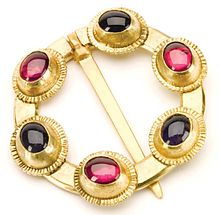Robbery of King Edward II's Treasure
The robbery of Edward II's treasure probably took place in Swansea in November 1326 after the fall and capture of the English king.
Escape of the king with the treasure
When the English King Edward II and his favorite Hugh le Despenser fled London at the beginning of October 1326 after the invasion of Queen Isabelle and her lover Roger Mortimer , the royal treasurer John Langton accompanied them with the rich throne. After the planned escape to Ireland was not possible due to bad weather, they fled to South Wales, where Despenser owned extensive estates with heavily fortified castles. The King acknowledged the handover of a treasure worth over £ 29,000 to Langton on October 20th at Chepstow Castle . On October 27, 1326 they landed at Cardiff Castle , from where they reached the heavily fortified Caerphilly Castle on October 29 . There they left Despenser's young son and much of their treasure, approximately £ 13,000, on November 2nd under the protection of a strong garrison under the command of John Felton . They took at least £ 6,000 and other valuables and documents with them on their further escape.
Via Margam Abbey they reached Neath Abbey and Neath Castle , another castle of Despensers, on November 5th . The Queen and Mortimer pursued them as far as Hereford and commissioned Henry of Lancaster to capture the king and Despenser. On November 10, the king, his chancellor Robert Baldock and Despenser left Neath Abbey, accompanied by Simon of Reading and a few other followers. On November 16, they were captured in a forest near Llantrisant by men of Rhys ap Howel , a retainer of Mortimer, and men of Lancaster after being betrayed by the population. Despenser was brought to Hereford and executed on November 26th, the king had to renounce the throne in January 1327 and was probably murdered in September 1327.
Investigations into the whereabouts of the treasure
After Caerphilly Castle surrendered in March 1327, Queen Isabelle and Mortimer secured part of the royal treasure, but at least £ 3,000 had disappeared in the turmoil after the king's arrest, and the treasure had probably been stolen. This led to years of research, and in 1331 the new King Edward III. Richard Peshale and David de la Bere with further investigations. The investigations came to the result that the treasure was first brought to Swansea Castle in November 1326 by order of Edward II of Neath , where it was to be kept by the constable of Kidwelly Castle and other nobles. The further whereabouts of the treasure could then no longer be clarified. While a number of members of the were Gentry of Kidwelly and Robert de Penres of Penrice Castle and other members of the gentry of Gower suspected of having stolen the treasure in Swansea, but the suspect could not be detected. Cadwgan ap Gruffydd, the head of the Dwnn family from Kidwelly, was questioned without result in 1334. He was one of the followers of Henry of Lancaster, seven other members of his family were also among the suspects.
Possible finds of the treasure
In November 1956, while work was being carried out in Neath Abbey, an originally hastily hidden small treasure totaling 100 silver coins from the reigns of Edward I and Edward II was discovered. All coins were minted before 1326 and therefore surely come from the lost treasure of Edward II.
In 1968, during restoration work at Oxwich Castle on the Gower Peninsula, a 44mm gold brooch dating from the first quarter of the 14th century was discovered. It is believed that the brooch was part of the treasure stolen in Swansea. The brooch could also have been acquired by the Mansel family , the builders of the manor house in the 16th century, but the family had acquired the property of the Penres family and thus from Robert de Penres by marriage around 1400; a direct ancestor of the Family themselves were suspected in 1331.
Individual evidence
- ^ Natalie Fryde: The tyranny and fall of Edward II, 1321-1326 . Cambridge University Press, Cambridge 2003. ISBN 0-521-54806-3 , p. 105.
- ↑ Seymour Phillips: Edward II . New Haven, Yale University Press 2010. ISBN 978-0-300-15657-7 , pp. 514.
- ↑ Seymour Phillips: Edward II . New Haven, Yale University Press 2010. ISBN 978-0-300-15657-7 , p. 519.
- ^ Diane M. Williams: Gower. A Guide to ancient and historic monuments on the Gower peninsula. Cadw, Cardiff 1998. ISBN 1-85760-073-8 , p. 17.
- ↑ David Sutton: Kidwelly and the lost treasure of Edward II (Kidwelly History). Retrieved March 4, 2015 .
- ^ HM Dolley: A find of pence of Edward I and II at Neath Abbey . In: British Numismatic Journal, 28 (1957), pp. 294-299 online
- ^ South Wales Evening Post; September 15, 2012: King's treasure uncovered. Retrieved March 4, 2015 .
- ^ Diane M. Williams: Gower. A Guide to ancient and historic monuments on the Gower peninsula. Cadw, Cardiff 1998. ISBN 1-85760-073-8 , p. 36.

